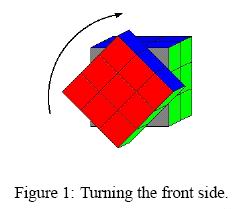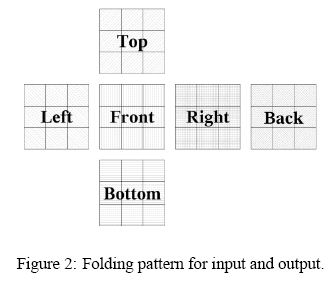POJ 1955 Rubik's Cube
暴力模拟就好了。。。。
vim写代码真费事,手都写酸了。。。
| Time Limit: 1000MS | Memory Limit: 30000K | |
| Total Submissions: 638 | Accepted: 324 |
Description
Rummaging through the stuff of your childhood you find an old toy which you identify as the famous Rubik's Cube. While playing around with it you have to acknowledge that throughout the years your ability to solve the puzzle has not improved a bit. But because you always wanted to understand the thing and the only other thing you could do right now is to prepare for an exam, you decide to give it a try. Luckily the brother of your girlfriend is an expert and able to fix the cube no matter how messed-up it is. The problem is that he stays with his girlfriend in the Netherlands most of the time, so you need a solution for long-distance learning. You decide to implement a program which is able to document the state of the cube and the turns to be made.
Problem
A Rubik's Cube is covered with 54 square areas called facelets, 9 facelets on each of its six sides. Each facelet has a certain color. Usually when the cube is in its starting state, all facelets belonging to one side have the same color. For the original cube these are red, yellow, green, blue, white and orange.

The positions of the facelets can be changed by turning the sides of the cube. This moves nine "little cubes" together with their attached facelets into a new position (see Fig. 1).
The problem is to determine how the facelets of the entire cube are colored after turning different sides in different directions.
Input
The starting state describes the colors of the facelets and where they are positioned. The colors are identified by single characters, and one character is given per facelet. Characters are separated by blanks and arranged in a certain pattern (see Fig. 2). The pattern identifies all six sides of the cube and can be thought of as a folding pattern. As shown in Fig. 2, the description of the top side of the cube is placed right over the description of the front side. This is done by indenting the lines with blanks. The next three lines contain the descriptions of the left, front, right and back side as shown in Fig. 2. The descriptions are simply concatenated with a blank character used as separator. After that the description of the bottom side follows, using the same format as the one used to describe the top side. This concludes the description of the starting state.
Then follows the second section of the scenario containing the turns which have to be performed. The description of the turns starts with a line containing the number of turns t (t > 0). Each turn is given in a separate line and consists of two integer values s and d which are separated by a single blank. The first value s determines the side of the cube which has to be turned. The sides are serially numbered as follows:left '0', front '1', right '2', back '3', top '4', bottom '5'. The second value d determines in which direction

the side s has to be turned and can either be '1' or '-1'. A '1' stands for clockwise and a '-1' for counterclockwise.The direction is given under the assumption that the viewer is looking directly at the specific side of the cube.
Output
Sample Input
2
w w w
w w w
w w w
r r r g g g b b b o o o
r r r g g g b b b o o o
r r r g g g b b b o o o
y y y
y y y
y y y
2
3 1
0 -1
g b b
g w w
g w w
r r r y g g b b y o o w
r r r y g g b b y o o w
w w w r g g b b y o o b
o y y
o y y
o r r
2
0 1
3 -1
Sample Output
Scenario #1:
g b b
g w w
g w w
r r r y g g b b y o o w
r r r y g g b b y o o w
w w w r g g b b y o o b
o y y
o y y
o r r Scenario #2:
w w w
w w w
w w w
r r r g g g b b b o o o
r r r g g g b b b o o o
r r r g g g b b b o o o
y y y
y y y
y y y
Source
#include <iostream>
#include <cstdio>
#include <cstring> using namespace std; int mofang[60]; void SHOW()
{
int cnt=1;printf(" ");
for(int i=0;i<9;i++,cnt++)
{
printf("%c ",mofang[i]);
if(cnt%3==0)
{
if(i!=0) putchar(10);
if(i!=8) printf(" ");
}
}
cnt=1;
for(int i=9;i<45;i++,cnt++)
{
printf("%c ",mofang[i]);
if(cnt%12==0)
putchar(10);
}
cnt=1; printf(" ");
for(int i=45;i<54;i++,cnt++)
{
printf("%c ",mofang[i]);
if(cnt%3==0)
{
putchar(10);
if(i!=53) printf(" ");
}
}
putchar(10);
} void quanCLOCKwise(int a1,int a2,int a3,int a4,int a5,int a6,int a7,int a8,int a9)
{
int a,b,c;
a=mofang[a1]; b=mofang[a2]; c=mofang[a3];
mofang[a1]=mofang[a7]; mofang[a2]=mofang[a4]; mofang[a3]=a;
mofang[a7]=mofang[a9]; mofang[a4]=mofang[a8]; mofang[a8]=mofang[a6];
mofang[a6]=b; mofang[a9]=c;
} void quanFANCLOCKwise(int a1,int a2,int a3,int a4,int a5,int a6,int a7,int a8,int a9)
{
int a=mofang[a1],b=mofang[a2],c=mofang[a3];
mofang[a1]=c; mofang[a2]=mofang[a6]; mofang[a3]=mofang[a9];
mofang[a6]=mofang[a8];mofang[a9]=mofang[a7];
mofang[a7]=a; mofang[a8]=mofang[a4];mofang[a4]=b;
} void huanCLOCKwise(int a1,int a2,int a3,int a4,int a5,int a6,int a7,int a8,int a9,int a10,int a11,int a12)
{
int a=mofang[a1],b=mofang[a2],c=mofang[a3];
mofang[a1]=mofang[a10]; mofang[a2]=mofang[a11];mofang[a3]=mofang[a12];
mofang[a10]=mofang[a7];mofang[a11]=mofang[a8];mofang[a12]=mofang[a9];
mofang[a9]=mofang[a6];mofang[a8]=mofang[a5];mofang[a7]=mofang[a4];
mofang[a6]=c; mofang[a5]=b; mofang[a4]=a;
} void huanFANCLOCKwise (int a1,int a2,int a3,int a4,int a5,int a6,int a7,int a8,int a9,int a10,int a11,int a12)
{
int a=mofang[a1],b=mofang[a2],c=mofang[a3];
mofang[a1]=mofang[a4]; mofang[a2]=mofang[a5]; mofang[a3]=mofang[a6];
mofang[a4]=mofang[a7]; mofang[a5]=mofang[a8]; mofang[a6]=mofang[a9];
mofang[a9]=mofang[a12]; mofang[a8]=mofang[a11]; mofang[a7]=mofang[a10];
mofang[a10]=a; mofang[a11]=b; mofang[a12]=c;
} void QianClockwise()
{
quanCLOCKwise(12,13,14,24,25,26,36,37,38);
huanCLOCKwise(6,7,8,15,27,39,47,46,45,35,23,11);
} void QianFanClockwise()
{
quanFANCLOCKwise(12,13,14,24,25,26,36,37,38);
huanFANCLOCKwise(6,7,8,15,27,39,47,46,45,35,23,11);
} void BackClockwise()
{
quanCLOCKwise(18,19,20,30,31,32,42,43,44);
huanCLOCKwise(2,1,0,9,21,33,51,52,53,41,29,17);
} void BackFanClockwise()
{
quanFANCLOCKwise(18,19,20,30,31,32,42,43,44);
huanFANCLOCKwise(2,1,0,9,21,33,51,52,53,41,29,17);
} void LeftClockwise()
{
quanCLOCKwise(9,10,11,21,22,23,33,34,35);
huanCLOCKwise(0,3,6,12,24,36,45,48,51,44,32,20);
} void LeftFanClockwise()
{
quanFANCLOCKwise(9,10,11,21,22,23,33,34,35);
huanFANCLOCKwise(0,3,6,12,24,36,45,48,51,44,32,20);
} void RightClockwise()
{
quanCLOCKwise(15,16,17,27,28,29,39,40,41);
huanCLOCKwise(8,5,2,18,30,42,53,50,47,38,26,14);
} void RightFanClockwise()
{
quanFANCLOCKwise(15,16,17,27,28,29,39,40,41);
huanFANCLOCKwise(8,5,2,18,30,42,53,50,47,38,26,14);
} void TopClockwise()
{
quanCLOCKwise(0,1,2,3,4,5,6,7,8);
huanCLOCKwise(20,19,18,17,16,15,14,13,12,11,10,9);
} void TopFanClockwise()
{
quanFANCLOCKwise(0,1,2,3,4,5,6,7,8);
huanFANCLOCKwise(20,19,18,17,16,15,14,13,12,11,10,9);
} void BotClockwise()
{
quanCLOCKwise(45,46,47,48,49,50,51,52,53);
huanCLOCKwise(36,37,38,39,40,41,42,43,44,33,34,35);
} void BotFanClockwise()
{
quanFANCLOCKwise(45,46,47,48,49,50,51,52,53);
huanFANCLOCKwise(36,37,38,39,40,41,42,43,44,33,34,35);
} int main()
{
int t,cas=1;
scanf("%d",&t);
while(t--)
{
printf("Scenario #%d:\n",cas++);
for(int i=0;i<54;i++)
{
char c[3];
scanf("%s",c);
mofang[i]=(int)c[0];
}
int m;
scanf("%d",&m);
while(m--)
{
int a,b;
scanf("%d%d",&a,&b);
if(a==0)
{
if(b==1) LeftClockwise();
else LeftFanClockwise();
}
else if(a==1)
{
if(b==1) QianClockwise();
else QianFanClockwise();
}
else if(a==2)
{
if(b==1) RightClockwise();
else RightFanClockwise();
}
else if(a==3)
{
if(b==1) BackClockwise();
else BackFanClockwise();
}
else if(a==4)
{
if(b==1) TopClockwise();
else TopFanClockwise();
}
else if(a==5)
{
if(b==1) BotClockwise();
else BotFanClockwise();
}
}
SHOW();
}
return 0;
}
POJ 1955 Rubik's Cube的更多相关文章
- sdutoj 2606 Rubik’s cube
http://acm.sdut.edu.cn/sdutoj/problem.php?action=showproblem&problemid=2606 Rubik’s cube Time Li ...
- The Mathematics of the Rubik’s Cube
https://web.mit.edu/sp.268/www/rubik.pdf Introduction to Group Theory and Permutation Puzzles March ...
- HDU 5836 Rubik's Cube BFS
Rubik's Cube 题目连接: http://acm.hdu.edu.cn/showproblem.php?pid=5836 Description As we all know, Zhu is ...
- hduoj 3459 Rubik 2×2×2
http://acm.hdu.edu.cn/showproblem.php?pid=3459 Rubik 2×2×2 Time Limit: 10000/5000 MS (Java/Others) ...
- squee_spoon and his Cube VI(贪心,找不含一组字符串的最大长度+kmp)
1818: squee_spoon and his Cube VI Time Limit: 1 Sec Memory Limit: 128 MB Submit: 77 Solved: 22Subm ...
- HDU5983Pocket Cube
Pocket Cube Time Limit: 2000/1000 MS (Java/Others) Memory Limit: 65536/65536 K (Java/Others) Tota ...
- Pocket Cube
Pocket Cube http://acm.hdu.edu.cn/showproblem.php?pid=5983 Time Limit: 2000/1000 MS (Java/Others) ...
- HDU 5292 Pocket Cube 结论题
Pocket Cube 题目连接: http://acm.hdu.edu.cn/showproblem.php?pid=5292 Description Pocket Cube is the 2×2× ...
- squee_spoon and his Cube VI---郑大校赛(求最长子串)
市面上最常见的魔方,是三阶魔方,英文名为Rubik's Cube,以魔方的发明者鲁比克教授的名字命名.另外,二阶魔方叫Pocket Cube,它只有2*2*2个角块,通常也就比较小:四阶魔方叫Reve ...
随机推荐
- ZOJ 2972 Hurdles of 110m 【DP 背包】
一共有N段过程,每段过程里可以选择 快速跑. 匀速跑 和 慢速跑 对于快速跑会消耗F1 的能量, 慢速跑会集聚F2的能量 选手一开始有M的能量,即能量上限 求通过全程的最短时间 定义DP[i][j] ...
- CodeForces 385C Bear and Prime Numbers 素数打表
第一眼看这道题目的时候觉得可能会很难也看不太懂,但是看了给出的Hint之后思路就十分清晰了 Consider the first sample. Overall, the first sample h ...
- Jekyll搭建过程详解
原先博客用Jekyll搭建在Github上,近来访问缓慢,而且markdown不太方便写,故决定在博客园安个新家. 文章见Github博客: 搭建过程:http://wuxichen.github.i ...
- CodeIgniter 应用开发笔记 - 3
使用migration建数据表 一.新建migrations文件夹 在application新建一个文件夹migrations,存放建表类. 建表类使用用户手册中的代码作为模板(user_guide/ ...
- [Unity 3D] Unity 3D 性能优化 (一)
听到过很多用Unity 3D开发游戏的程序员抱怨引擎效率太低,资源占用太高,包括我自己在以往项目的开发中也头疼过.最近终于有了空闲,可以仔细的研究一下该如何优化Unity 3D下的游戏性能.其实国外有 ...
- Android 系统稳定性 - ANR(一)
文章都为原创,转载请注明出处,未经允许而盗用者追究法律责任.很久之前写的了,留着有点浪费,共享之.编写者:李文栋 如果你是一个Android应用程序开发人员,你的人生中不可避免的三件事情是:死亡.缴 ...
- MSSQL奇技淫巧
MSSQL:获得库每个表的记录数和容量 sp_msforeachtable是MS未公开的存储过程: exec sp_msforeachtable @command1="print '?'&q ...
- iOS开发中xib和Storyboard中需要注意的事项
使用xib注意事项: 1.只有自带view的控件才可以使用xib,因为它本身就是一个view 2.在使用可视化控件添加属性(代码)时候,如果删除了属性代码,一定要在xib上解除关联(不然会崩溃) 3. ...
- ELK 之一:ElasticSearch 基础和集群搭建
一:需求及基础: 场景: 1.开发人员不能登录线上服务器查看详细日志 2.各个系统都有日志,日志数据分散难以查找 3.日志数据量大,查询速度慢,或者数据不够实时 4.一个调用会涉及到多个系统,难以在这 ...
- LifecyclePhaseNotFoundException(转)
This error is generated if you try to invoke a build command that Maven does not understand. In gene ...
